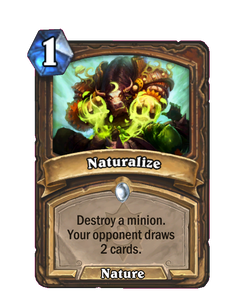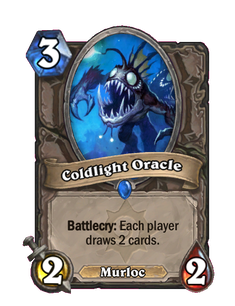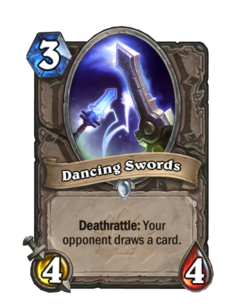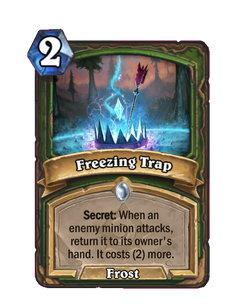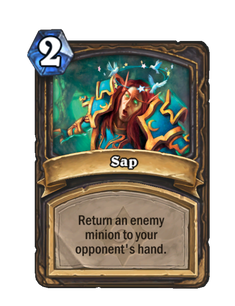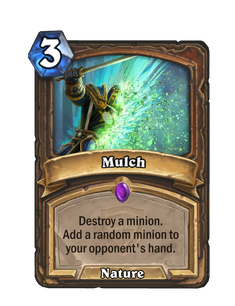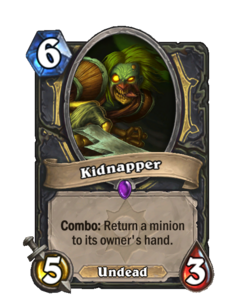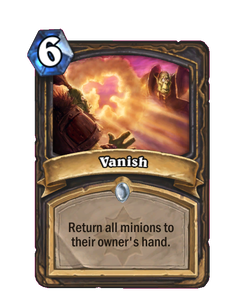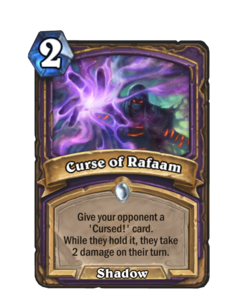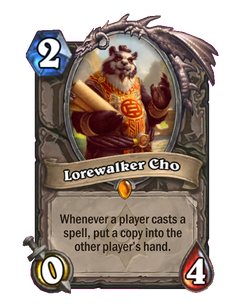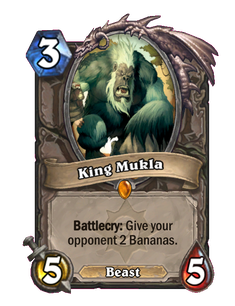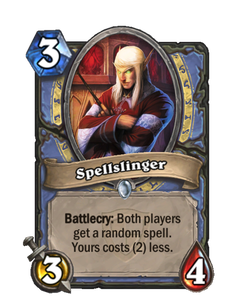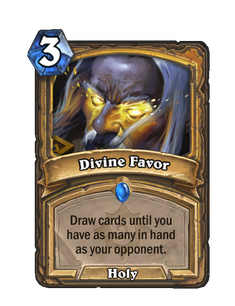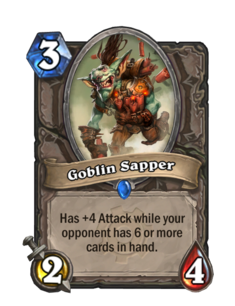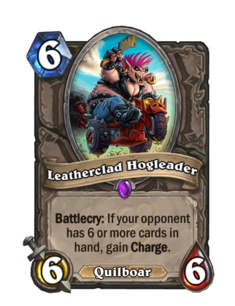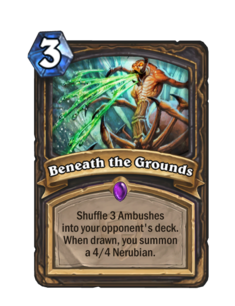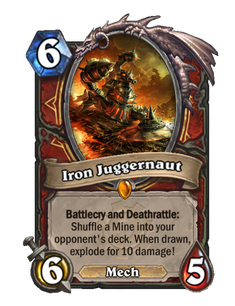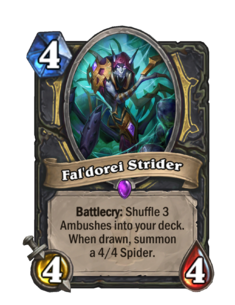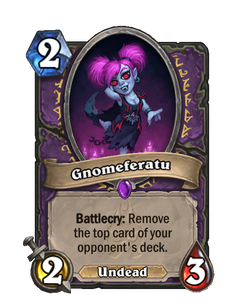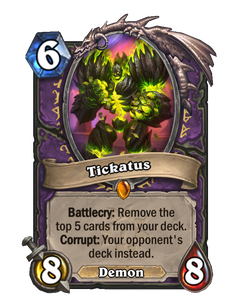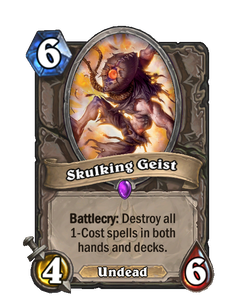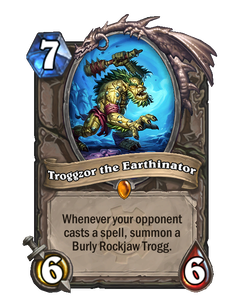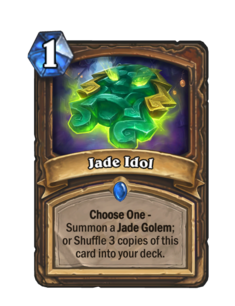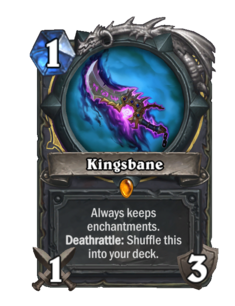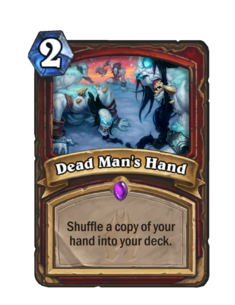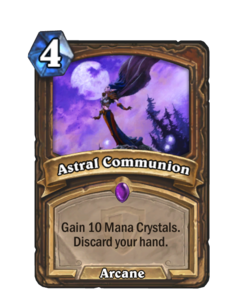Mill
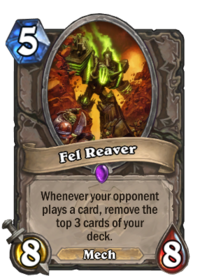
Milling is a term used in Hearthstone to refer to a range of phenomena related to card draw. The term may refer to the rapid drawing of cards from a player's deck; the burning of cards, usually due to drawing a card while already having a full hand; or the premature exhaustion of a player's deck and/or acceleration of fatigue damage.
The most common use of milling is in forcing the opponent to draw cards, with the goal the premature exhaustion of their deck, and consequent death to fatigue damage. A secondary goal is overdraw, where the drawn cards are destroyed due to the player's hand already being full, preventing the player from making use of those cards in that match. Once the player's deck has been exhausted, continued milling can be used to further accelerate fatigue damage.
Mill decks are decks which use milling to defeat the opponent. Control-type mill decks focus on forcing the opponent to draw a large number of cards, in order to accelerate the exhaustion of their deck, using premature fatigue damage as a direct means of defeating the opponent. These decks use healing and removal to slow the opponent's attack, and prolong the match for long enough for fatigue to wear the opponent down.
Strategy[edit | edit source]
The broader definition of milling includes any rapid drawing of cards from the deck. However, the term most commonly refers to the use of milling to force the opponent to prematurely exhaust their deck, for the purpose of causing them to suffer fatigue damage.
Decks which centre around building and maintaining large hands, such as Handlock, are especially vulnerable to milling, since in many cases the player will already have a full hand before milling commences. This often allows overdraw to be achieved immediately. Milling is also especially effective against decks which themselves contain a substantial amount of card draw, or warlocks who have already used ![]() Life Tap several times that match; in both cases the player will already have progressed significantly toward fatigue, allowing milling to exhaust the deck several turns earlier than usual. Decks featuring multiple card draw effects are especially vulnerable, as this may cause playing cards such as
Life Tap several times that match; in both cases the player will already have progressed significantly toward fatigue, allowing milling to exhaust the deck several turns earlier than usual. Decks featuring multiple card draw effects are especially vulnerable, as this may cause playing cards such as ![]() Acolyte of Pain or
Acolyte of Pain or ![]() Power Word: Shield highly undesirable, further filling the hand and restricting play options.
Power Word: Shield highly undesirable, further filling the hand and restricting play options.
Side benefits of milling include making use of cards like ![]() Clockwork Giant and
Clockwork Giant and ![]() Goblin Sapper. These synergies are identical to those found when playing against decks which intentionally build a large hand.
Goblin Sapper. These synergies are identical to those found when playing against decks which intentionally build a large hand.
Milling aims to cause cards to be burnt through overdraw, but can also allow cards to be burnt through using Return effects on an enemy minion while they have a full hand; the minion will instead be destroyed. Mill rogue decks use cards like ![]() Coldlight Oracle and
Coldlight Oracle and ![]() King Mukla to fill the opponent's hand, followed by cards like
King Mukla to fill the opponent's hand, followed by cards like ![]() Sap to destroy valuable targets.
Sap to destroy valuable targets.
It is important to understand that as a rule overdraw does not in itself provide advantage, until the opponent reaches fatigue. The reason for this is that since each deck is randomly ordered, if the game ends before the deck is exhausted, there is no practical difference between burning the top 5 cards of a player's deck, and simply shuffling them to the bottom; in either case those cards will not be drawn. Additionally, since the order is random, there is no way of knowing which cards are about to be drawn, thus providing no advantage or disadvantage from rearranging the order of the deck. For a fuller explanation, see ![]() Fel Reaver.
Fel Reaver.
However, overdraw does have one strategic benefit: it allows the opponent to see which card has been discarded. In constructed play, discarding a legendary or the second copy of a non-legendary card will confirm that the player does not have any copies of that card remaining in their deck (or hand). This can be very valuable strategically, especially if the player knows that card to be critical to the function of the opponent's deck (eg ![]() Alexstrasza in a Freeze Mage deck). In addition, overdraw can have the important effect of demoralising the opponent, especially if they do not understand the above points regarding the difference between overdraw and deck exhaustion. The counterpoint to this is that the player can plan around the loss of their cards, since they can be certain which options are no longer available to them.
Alexstrasza in a Freeze Mage deck). In addition, overdraw can have the important effect of demoralising the opponent, especially if they do not understand the above points regarding the difference between overdraw and deck exhaustion. The counterpoint to this is that the player can plan around the loss of their cards, since they can be certain which options are no longer available to them.

If you find yourself with a deck with negative Cast When Drawn effects, such as ![]() Bomb,
Bomb, ![]() Darkness Candle,
Darkness Candle, ![]() Corrupted Blood, or
Corrupted Blood, or ![]() Nerubian Ambush!, you may find it more valuable to forcibly mill yourself instead. If you feel like you can win without anything in your deck, and can survive until these threats are neutralized, you can play this milling effect to your advantage by filling up your own hand. This strategy also applies to
Nerubian Ambush!, you may find it more valuable to forcibly mill yourself instead. If you feel like you can win without anything in your deck, and can survive until these threats are neutralized, you can play this milling effect to your advantage by filling up your own hand. This strategy also applies to ![]() Mecha'thun decks, where you aim to wholly trash your own deck and no longer care about the contents of it after your combo pieces are drawn.
Mecha'thun decks, where you aim to wholly trash your own deck and no longer care about the contents of it after your combo pieces are drawn.
Related card phenomena include (in order of strictness):
- Forcing card draw (
 Coldlight Oracle,
Coldlight Oracle,  Naturalize) or putting cards directly into play (
Naturalize) or putting cards directly into play ( Deathlord)
Deathlord) - Directly removing cards from the deck (
 Fel Reaver)
Fel Reaver) - Filling the opponent's hand (
 King Mukla,
King Mukla,  Lorewalker Cho)
Lorewalker Cho) - Return effects, which will destroy the minion if the controlling player's hand is full (
 Sap,
Sap,  Freezing Trap)
Freezing Trap) - Synergies with the opponent's hand size (
 Clockwork Giant,
Clockwork Giant,  Divine Favor)
Divine Favor) - Synergies with card draw (
 Burrowing Mine)
Burrowing Mine) - Cards thwarting opposing card play in a significant way, thus preventing them from emptying their hand (
 Loatheb,
Loatheb,  Nozdormu)
Nozdormu)
Anti-mill concepts include:
- Shuffle into deck effects (
 Malorne,
Malorne,  Gang Up)
Gang Up) - Avoiding fatigue damage (Immune) or healing through it (
 Tree of Life,
Tree of Life,  Antique Healbot)
Antique Healbot) - Generate effects, which create entirely new cards (
 Thoughtsteal)
Thoughtsteal)
Mill decks[edit | edit source]
Mill decks can be either aggression or control oriented. Control mill decks use milling as a primary win condition, seeking to cause the opponent to die to fatigue damage, while using healing removal to stay alive; while aggressive mill decks tend to feature milling as an occasional deck mechanic, complementing a more conventional aggressive deck.
Mill decks generally struggle against aggressive decks while having an advantage against control and draw heavy decks.
Aggressive mill[edit | edit source]
Aggressive mill decks are primarily aggressive decks of other types, with some elements of milling included. These decks seek to kill the opponent by means of minions, spells or weapons, while using mill effects to confound, disrupt otherwise weaken the opponent. These kinds of decks usually features cheap symmetrical card draw, cost effective cards and heavy face damage, and do not expect to reach fatigue, making overdraw only of strategic significance. Rogue is the most common class for an aggressive mill deck.
Milling in aggressive mill decks features, in a minor capacity, filling the hand through cards like ![]() King Mukla or
King Mukla or ![]() Lorewalker Cho, and then destroying minions using Return effects like
Lorewalker Cho, and then destroying minions using Return effects like ![]() Sap.
Sap. ![]() Coldlight Oracle is also common, ideally causing the opponent to burn cards. Fatigue is at best a backup win condition, since these decks seek to defeat the opponent relatively quickly.
Coldlight Oracle is also common, ideally causing the opponent to burn cards. Fatigue is at best a backup win condition, since these decks seek to defeat the opponent relatively quickly.
Control mill[edit | edit source]
Control oriented mill decks also seek to fill the opposing hand, but usually at timed intervals and with less useful cards (Spare Parts, ![]() Bananas). This is then abused through cards benefiting from the opponents hand size and selective card burning. Control mill decks are almost always druid decks.
Bananas). This is then abused through cards benefiting from the opponents hand size and selective card burning. Control mill decks are almost always druid decks.
Control-type mill decks seek to outlast the opponent, by causing the opponent to reach fatigue several turns early, and by using Taunts, removal and healing to prolong their own survival. Cards like ![]() Antique Healbot and
Antique Healbot and ![]() Healing Touch can be used to counter damage suffered while focusing on milling, and to compensate for an otherwise weak and ineffective deck.
Healing Touch can be used to counter damage suffered while focusing on milling, and to compensate for an otherwise weak and ineffective deck.
Control-type mill decks are very slow to play, with long matches required in order to achieve victory, due to lacking means of defeating the opponent aside from fatigue.
Examples cards[edit | edit source]
Below are some examples of key cards for mill decks.
Milling[edit | edit source]
Many of these are core parts of the mill archetype.
Opponent card draw[edit | edit source]
These cards force the opponent to draw cards, depleting their deck and possibly forcing overdraw, destroying the drawn card/s.
Return effects[edit | edit source]
These cards return minions to the opponent's hand. This can result in minions being destroyed due to the opponent's hand being too full, and/or overdraw next turn.
Generating cards for the opponent[edit | edit source]
These cards generate new cards for the opponent, adding them to their hand, making overdraw more likely.
Mill synergy cards[edit | edit source]
Exploiting opponent's hand size[edit | edit source]
Exploiting opponent's card draw[edit | edit source]
These cards shuffle into the opponent's deck cards that cause negative effects when drawn. However, they do not delay fatigue as the new cards will draw another card when drawn, except that overdraw will destroy Nerubian Ambush! and Burrowing Mine rather than triggering card draw and their effects.
Card destroying effects[edit | edit source]
Deterring card-playing[edit | edit source]
Mill countering cards[edit | edit source]
Replace deck[edit | edit source]
Shuffle into deck[edit | edit source]
Tempo gain[edit | edit source]
History[edit | edit source]
Milling in Hearthstone was something that players had attempted to make viable since the game's beta. However, a lack of the proper cards made it hard to make an effective deck of this type, beyond the occasional burning of enemy cards through overdraw or returning a minion to a full hand. 'Mill rogue' decks were the primary mill decks, using ![]() Coldlight Oracle,
Coldlight Oracle, ![]() King Mukla and
King Mukla and ![]() Sap to burn the opponent's cards, but did not have any relationship to fatigue damage. Such decks used milling as a fun gimmick or occasional side-effect, but without any expectation of actually exhausting the opponent's deck, and the archetype was not considered competitive. Most mill decks were aggressive mill decks.
Sap to burn the opponent's cards, but did not have any relationship to fatigue damage. Such decks used milling as a fun gimmick or occasional side-effect, but without any expectation of actually exhausting the opponent's deck, and the archetype was not considered competitive. Most mill decks were aggressive mill decks.
Curse of Naxxramas introduced a few mill-related cards such as ![]() Dancing Swords and
Dancing Swords and ![]() Deathlord, making the mill concept more desirable, especially for druids, but the concept remained largely unimplemented. The adventure did however see milling used against bosses such as Patchwerk, where the forced drawing of the enemy's deck could be used to quickly defeat him.
Deathlord, making the mill concept more desirable, especially for druids, but the concept remained largely unimplemented. The adventure did however see milling used against bosses such as Patchwerk, where the forced drawing of the enemy's deck could be used to quickly defeat him.
It was not until Goblins vs Gnomes that the concept of milling was made viable in Hearthstone as a main deck focus. The introduction of powerful healing effects like ![]() Tree of Life and
Tree of Life and ![]() Antique Healbot allowed for extremely long-lasting mill druid decks, allowing room for underused cards like
Antique Healbot allowed for extremely long-lasting mill druid decks, allowing room for underused cards like ![]() Naturalize and
Naturalize and ![]() Dancing Swords to shine. The expansion also brought mill-synergy with
Dancing Swords to shine. The expansion also brought mill-synergy with ![]() Clockwork Giant and
Clockwork Giant and ![]() Goblin Sapper, as well as negative self-mill in the form of
Goblin Sapper, as well as negative self-mill in the form of ![]() Fel Reaver, allowing players to gain a powerful minion in exchange for giving the opponent the opportunity to mill their deck.
Fel Reaver, allowing players to gain a powerful minion in exchange for giving the opponent the opportunity to mill their deck.
Shortly after the release of Goblins vs Gnomes, for the first time in the game's history true mill decks became commonplace - and relatively competitive - in the form of mill druid. These control mill decks used multiple healing and removal options to outlast the opponent, while using a range of card draw effects to push them into fatigue several turns early. Mill druid decks quickly became infamous for their extremely long matches, drawing out games and in many ways epitomising the control deck type, having few means of defeating the opponent aside from allow the player's own fatigue to put an end to them.
Perhaps one of the most crucial cards that catapulted Mill Rogue into the spotlight was ![]() Gang Up, introduced in Blackrock Mountain, which introduced one of the few ways a player could consistently give themselves a larger deck than their opponent. The class's various "Return to hand" tools such as
Gang Up, introduced in Blackrock Mountain, which introduced one of the few ways a player could consistently give themselves a larger deck than their opponent. The class's various "Return to hand" tools such as ![]() Shadowstep and
Shadowstep and ![]() Vanish helped to make abusing Coldlight Oracle's draw more frequent, and the subsequent release of
Vanish helped to make abusing Coldlight Oracle's draw more frequent, and the subsequent release of ![]() Brann Bronzebeard from the The League of Explorers sharply increased the odds of players getting their cards burned.
Brann Bronzebeard from the The League of Explorers sharply increased the odds of players getting their cards burned.
In the sets that followed, Mill strategies would see both support and anti-support printed, with cards such as Jade Druid, ![]() Dead Man's Hand,
Dead Man's Hand, ![]() Archbishop Benedictus and
Archbishop Benedictus and ![]() Prince Malchezaar either contributing to slower fatigue strategies or as a tech against deck depletion. Mill's final hurrah in Standard would come in the form of Kingsbane Rogue, which sometimes ran Mill synergies while being immune to fatigue damage thanks to Kingsbane's return to the deck upon its Deathrattle triggering, allowing the player to draw into crucial cards while wasting the opponent's.
Prince Malchezaar either contributing to slower fatigue strategies or as a tech against deck depletion. Mill's final hurrah in Standard would come in the form of Kingsbane Rogue, which sometimes ran Mill synergies while being immune to fatigue damage thanks to Kingsbane's return to the deck upon its Deathrattle triggering, allowing the player to draw into crucial cards while wasting the opponent's.
The announcement of Coldlight Oracle's move to the Hall of Fame meant the death of Mill as an archetype in Standard; a move that was met by heated arguments on both sides of the Mill debate. Detractors of Mill decks declared that Mill decks were inherently un-fun to play against and Mill decks tended to destroy control-oriented decks, mirroring Team 5's own rationale on Coldlight Oracle's move: "Its “downside” can destroy opponent's cards and prevent opponents from playing the deck they built". Supporters of Mill, on the other hand, pointed out that Mill was inherently risky as it also filled the opponent's hand with resources, the playstyle was often dead against aggro-style decks, and control decks could still be built to handle Mill; overall, the move felt like punishing a deck build that required skill to pilot, did not have consistent results and was far less oppressing on the meta than other popular decks.
As of the Year of the Dragon, Mill decks occupy a small portion of the Wild meta - appearing on occasion but rarely being competitive enough to be a significant force, while still preying on decks based around control, combos or Highlander builds.
Pre-Hearthstone[edit | edit source]
Milling itself is a trope imported from Magic the Gathering (MTG) to Hearthstone (HS) vocabulary. The trope namer, Millstone, was the first card in MTG to feature the mechanic of directly removing cards from decks. The card gained notoriety for introducing a new feasible way of meeting an otherwise elusive win condition, specifically winning through the opponent not being able to draw anymore cards. HS features a similar win condition with players starting to take fatigue damage when running out of cards.
Without the Graveyard-concept present in MTG, the strictest interpretation of Mill in Hearthstone only includes effects directly removing cards from a player's library out of the game. However, since true milling sees little occurrence in HS, the concept has been expanded to include any means of removing cards from the opponent deck. This is most commonly done through forced card draws. Mill decks then seek to minimize the usefulness of cards in the opponent's hand.
External links[edit | edit source]
- Brian Kibler - Understanding Fel Reaver: Hearthstone Theory (2014-12-17) - Exploring the history of Milling in Magic: The Gathering and how it relates to Hearthstone

